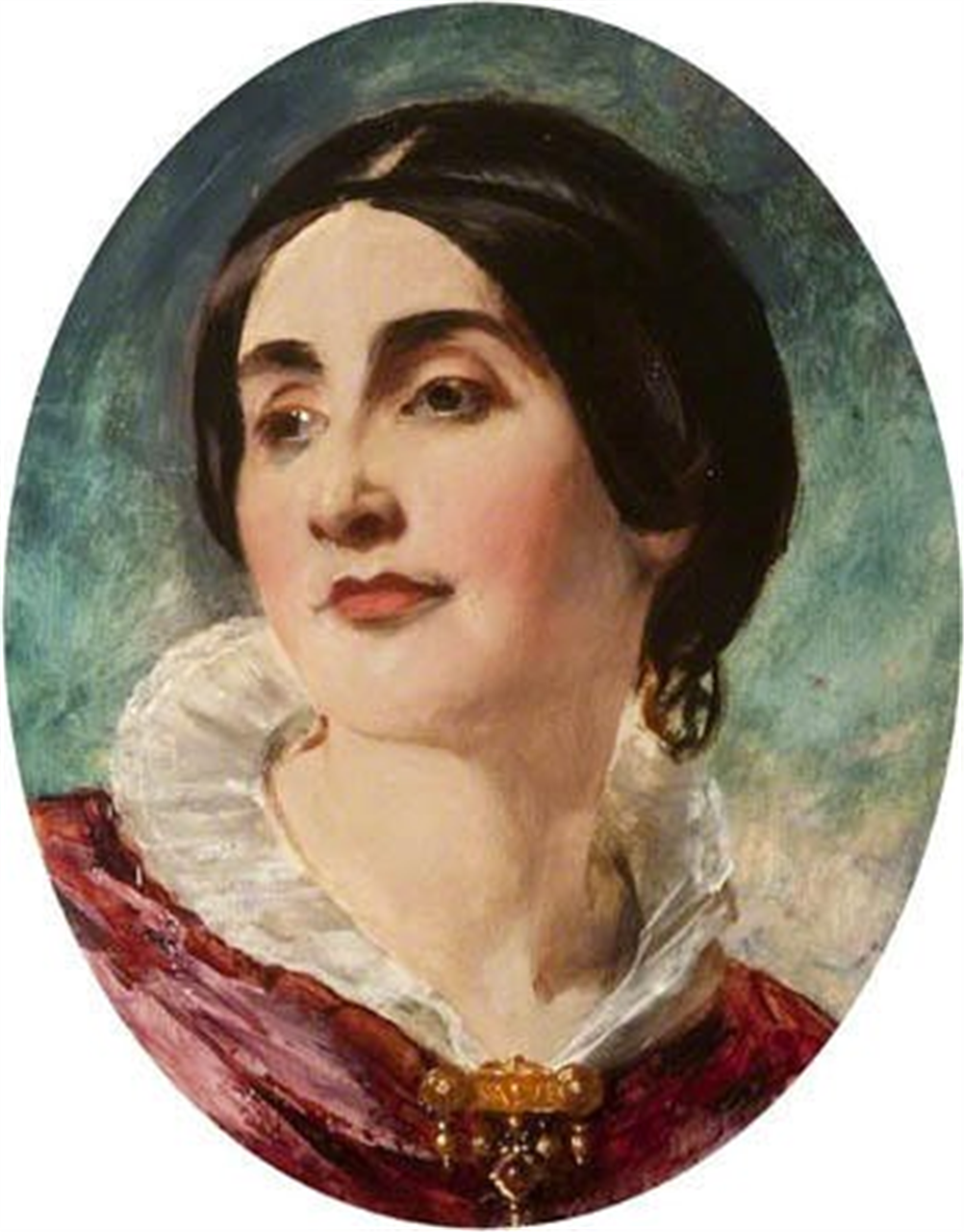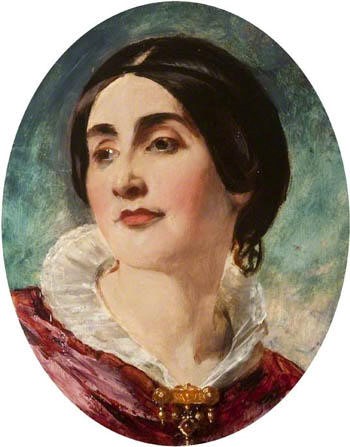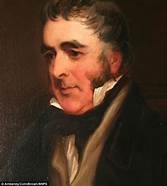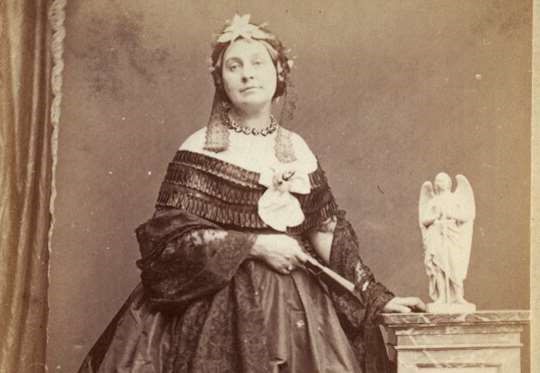
Caroline Norton – Family Law’s Forgotten Heroine
Published: 09/03/2022 08:59

1836 Caroline Norton by William Etty
Introduction
At the cemetery at Lecropt Kirk,1 Bridge Allan, Stirling, Scotland, Caroline Elizabeth Sarah Sheridan Norton (22.03.1808 to 15.06.1877) lies in rest in the Stirling Maxwell vault nearby the grave of one of her three children William Charles Chapple Norton (26.08.1833 to 12.09.1842).2 The proximity in this graveyard of her son is a poignant reminder of the tragic life of a woman, who in her time did more than any other individual in modern legal history to lay the foundations of our current civil divorce system and to advance the claims of women in the face of domestic violence upon marital breakdown and to secure their rights to custody of their children thereafter. Arguably, Lady Caroline Norton was this country’s first women’s rights protagonist.
Early years
Caroline, born in 1808, was the second of three daughters (known because of their beauty as ‘the three Graces’) of Thomas and Caroline Henrietta Callender Sheridan. Her grandfather, Richard Brinsley Sheridan,3 was then the well-known playwright and part owner of the Drury Lane Theatre. Unfortunately, due to her father’s untimely death from tuberculosis in 2017 when Caroline was just 8 years of age, the family of four sons and three daughters were placed in a serious financial situation.
In 1823, Caroline, as a girl now aged 15 and already a talented poetess, was also both high spirited and difficult to control, with a quick tongue and a habit of looking at others with her forehead lowered. Her mother therefore sent her to boarding school at Shalford nearby the then manor at Wonersh Park,4 Surrey, the home of Lord Grantley the brother of Caroline’s husband-to-be George Norton.
Marriage
George Chappell Norton5 (1800–1875) was attracted to Caroline’s beauty on first sight, albeit this reaction was not reciprocated. However, Norton’s attentions persisted and Caroline’s own choice of suitor had died suddenly, and so they were married on 30 July 1827, when Caroline was just 19.
George, now a Tory MP for Guildford and described as ‘slow, rather dull, jealous and obstinate’6 was quite the opposite of his young wife, an opinionated liberal, who was herself described as ‘quick-witted, vivacious, flirtatious and egotistical’. Predictably, their union was a disaster with constant arguments, particularly over politics and a woman’s place in society, which resulted in ever increasing violent outbursts by George upon Caroline.
Despite this, Caroline bore George three children, Fletcher (1829–59), Brinsley (1831–77) and William in (1833–42). These same years realised Caroline’s literary ambitions7 first her poem ‘Sorrows of Rosalie’ (1829), completed when she had been just 17, was published followed by ‘The Undying One’ (1830) followed by ‘The Wife and the Woman’s Reward’ (1835) and ‘The Coquette and Other Tales and Sketches, In Prose and Verse’ (1835) leading to her subsequent appointment as editor of society magazines.8 Throughout she maintained an influential circle of friends and associates, including the likes of William Thackeray, Benjamin Disraeli, Mary Shelley and Fanny Kemble.
Lord Melbourne
c.1836: Lord Melbourne
Her husband fared less well, losing his Parliamentary seat in 1830 in the general election, notwithstanding the Tories’ greater returns that year. A loss which his brother, the second Lord Grantley, suggested was the result of Norton’s neglect of his constituency duties. Embarrassingly, Norton was forced to ask his wife to use her influence to secure him an alternative income. This came through her friendship with the then Home Secretary, Lord Melbourne whereby Norton was made a magistrate at Lambeth on 1,000 pa – despite his complaint that he was worth more.
The marriage continued its downward and often violent spiral whilst Caroline’s relationship with Melbourne, some 28 years her senior became ever closer following his late wife’s demise. Norton’s domestic violence included him kicking, punching and slapping her, as well as attempted strangulation, inflicting burns and dragging her downstairs whilst 7 months pregnant. On a similar occasion she suffered a miscarriage and yet on another Norton in rage destroyed a door and surround locked against him by her.9
Aware of the Melbourne rumours concerning his wife in 1835 Norton, without notice and whilst Caroline was visiting her sister, removed their three children placing them in the charge of a female cousin of his and refused Caroline access. As the law then stood in pre-Victorian England, a mother had no rights concerning the custody of children without the consent of the husband. Indeed, all her income from her writings even after separation was in law her husband’s entitlement.
Conspiring with Melbourne’s political enemy, the Tory Lord Wynford, Norton informed Caroline, despite having his own mistress, that he would allege her adultery with Melbourne, now the Prime Minister. When his subsequent approach to Melbourne for a pay-off of £1,400 was rebuffed, Norton then leaked stories to the press alleging her association with numerous men. Melbourne fearing his political career was over offered his resignation to the new king, William IV, who declined the same – but, on condition he distanced himself from Caroline.
Criminal Conversation Trial
By June 1836, Norton had started an action against Melbourne for ‘criminal conversation’, claiming £10,000 in damages (over £1m today) for adultery. The trial was the scandal of the day,10 with Norton’s witnesses alleging, to Caroline’s great distress, her illicit conduct with a number of men and three letters between Caroline and Melbourne were exhibited of which the absence of the words ‘My dear Mrs Norton’ were claimed to indicate the improper intimacy of the correspondents. The evidence of servants even suggested Caroline had been seen exposed after a visit from Melbourne and with marks upon her undergarments indicating intercourse had taken place.
Despite this, the jury, as Norton’s own counsel, Sir William Follett, had himself privately predicted, was wholly unimpressed by the detail of the evidence presented by the witnesses and their demeanour, where one was obviously inebriated and where payments had been made for their testimony, to such a degree that after hearing a three and a half hour final submission by the Attorney General for Lord Melbourne, they summarily rejected Norton’s claim without hearing any witnesses for the defence.11 However, for Caroline the trial details had destroyed her reputation in society and Melbourne, in self-preservation, refused to have any dealings with her thereafter.
Custody of Infants Act 1839
Norton, in the wake of his court defeat, was in no mood to alleviate Caroline’s sufferings or relinquish his control over her and he continued to reject her pleas to have the children (aged 6, 4 and 2½ years on separation) or to even see the children alone, suggesting instead she could only ‘interview’ them in the presence of his lawyer.
In response, Caroline published a pamphlet entitled ‘The Natural Claim of a Mother to the Custody of her Children as affected by the Common Law Rights of the Father ‘(1837) and the following year ‘Separation of Mother and Child by the Laws of Custody Considered’. Subjectively she argued, in the first ever challenge to a man’s absolute rights to his children’s custody, that it could not be right that a husband under the law could desert his wife and refuse access to their children whilst having his mistress care for them.
Caroline found a natural ally in Thomas Talfourd (1795–1854)12 MP for Reading, a friend of both Lord Melbourne and Charles Dickens and a known supporter of women’s rights he agreed to introduce a Parliamentary bill allowing married women, who had not themselves committed adultery, to have custody of their children under 7 years of age and rights of access to older children.
The bill was however rejected by a low attended House of Lords, despite judicial support. Undaunted, Caroline produced a second pamphlet, entitled ‘A Plain Letter to the Lord Chancellor on the Law of Custody on Infants’, which she also ensured all MPs received a copy of. Talfourd again reintroduced the proposed legislation and, despite continued opposition, his bill was passed in 1839.
The Custody of Infants Act 1839, was the first direct incursion by Parliamentary legislation into what Blackstone previously had termed the ‘empire of the father’13 in describing the near absolute position of authority enjoyed hitherto by husbands in marriage and in relation to their children under the law.14
Death of youngest child
In the face of the new legislation, Norton had removed the children into the care of his sister, Lady Menzies, in Scotland outside the immediate jurisdiction of the English court. Caroline learnt that this woman had ‘flogged’ her eldest child for reading her letter to him and for correction had tied her youngest to a bed post and riding crop whipped him.
Despite some movement by Norton when Caroline proposed an application under the new law by his suggesting very limited access, in 1842, with the children in Scotland, tragedy befell Caroline again when the youngest, William, just 9 years old, left without supervision, rode out with his older brother and suffered an arm injury when thrown to the ground by his horse. Blood poisoning occurred, but only when the boy was gravely ill was Caroline informed by Norton – it had been 7 years since she had been allowed to see the children. She described the scene she was met by on her arrival at the Scottish train station:
‘Lady Kelly (who was an utter stranger to me) met me at the railway station. I said "I am here, is my boy better?" "No," she said, "he is not better, he is dead." And I found, instead of my child, a corpse already coffined.’15
Husband’s control
Unable as a woman, as the law then stood, to obtain a divorce and with Norton unwilling to divorce her, Caroline, following the death of young William, was granted by Norton more time with the two older children, but subject to his absolute right to remove them at will. Meanwhile he continued to benefit from her continued literary endeavours eg (1840) ‘The Dream and Other Poems’, in 1845 ‘The Child of the Islands’ and ‘Aunt Carry’s Ballads for Children’ in 1847.
This apparent truce was to be short lived. In 1848, facing some financial difficulty himself, Norton stopped his payment to her of £500 pa, which he had earlier agreed by deed to pay in return for his permitted access to family trust capital established years before by him. His reason for stopping the deed payment being that Lord Melbourne upon his death had left Caroline a small bequest as had her mother upon her own demise in 1851.
Enraged, Caroline referred her own creditors to Norton as she was entitled to do as her husband under the ‘law of coverture’ and he was sued for payment. In the resulting court proceedings, the Court however held as a married woman could not enter into a contract – then Norton could avoid the 1848 arrangement. Thereby, Caroline was again denied by the law, albeit not before she had yet again been subjected to cross examination during the hearing over her alleged liaisons with the late Lord Melbourne.16 In response, she turned her attention to changing the law, if not for herself, then for others of her gender.
Divorce reform
Following a Royal Commission17 which had recommended a review of divorce law, in 1854, Caroline’s extensive pamphlet English Laws for Women in the Nineteenth Century was published setting out the plight of married women under English Law and her eloquent arguments for change. Caroline wrote to the Lord Chancellor suggesting any reform required women to be able to own their own property in marriage and she also wrote direct to Queen Victoria – A Letter to the Queen on Lord Chancellor Cranworth’s Marriage and Divorce Bill, 185718 – educating a female sovereign of the plight under the law of the country’s married and separated women, and highlighting that a married woman:
- in England had no legal existence and years of separation after desertion could not alter this position.
- unless divorced by special House of Lords enactment, then by legal fiction she remained 'one' with her husband, even though she may never see or hear of him.
- had no possessions, unless by special settlement.
- could not hold her own property which in law was deemed to be her husband’s property.
- had no legal right even to her clothes or ornaments and even if bought before marriage.
- could not make a will and the law gave what she had to the husband.
- could not legally claim her own earnings, or in law leave her husband's house – indeed, a husband could sue her for 'restitution of conjugal rights,' and enter any house where she may seek and carry her away by force.
- claiming separation for cruelty, must establish such as 'endangers life or limb', and her 'condonation' of his offences, prevented reliance on the same.
- was not, in the first instance, in the face of the husband’s claim for divorce, allowed to defend herself and was not permitted to be a party to any damages suit between him and her supposed lover.
- if guilty of infidelity could not divorce the husband a vinculo, however profligate he may be and in only four instances (two of which were cases of incest), had the wife historically obtained a divorce from the House of Lords to marry again.
- could not prosecute for a libel or sign a lease or transact responsible business.
- need not be supported by her husband and he would be free of providing anything if she had her own means: even by inheritance and even if he had deserted her.
- could not bind her husband by any agreement, except through a third party and even a contract formally drawn witnessed, and signed by him, was void in law as a man could not contract with his own wife – their separation would not alter this.
- had no rights over her husband’s property yet he had a right to all that was hers.
- could only gain a separation from him, but then only in her married name.
Matrimonial Causes Act 1857
By 1857, there had been also a pamphlet by the younger Barbara Leigh-Smith entitled ‘A Brief Summary in Plain Language of the Most Important Laws Concerning Women: together with a few observations thereon’ (1854)19 and supportive articles published by the Morning Chronicle (1851) and John Stuart Mill’s Westminster Review (1849). The bill presented to Parliament in the same year, despite vociferous opposition from William Gladstone, was passed into law as the first Matrimonial Causes Act.20
The Act, albeit headlined at the time as of a procedural nature, introduced a significant change to the process of divorce and culturally to marriage as well (‘from dictatorship to partnership’), and for the first time (excluding Ireland) removed (cl II) the Ecclesiastes Court jurisdiction for matrimonial affairs and set up a new secular civil court (cl VI) jurisdiction headed by the Lord Chancellor (cl VIII) as is still in place today.
Under its provisions, women were allowed access to divorce. However, to obtain a divorce, men only needed to prove their wife’s adultery, whereas (by ‘the Gladstone double standard’ concession made by the Palmerston government) whereas the wife had to prove her husband’s adultery coupled with aggravating conduct (i.e. incest, rape, sodomy, bestiality, cruelty or desertion for 2 years or more without reasonable excuse). Actions for criminal conversations were abolished. Legal separation was available to either spouse on the basis of adultery, cruelty or desertion.
Directly influenced by Caroline’s campaign, the Act provided protection for women deserted by their husbands from any claim against their earnings, made provision for maintenance to a wife or her trustee, allowed a married woman’s right to inherit or leave property by will and permitted a separated wife the right to be a party to a contract or to sue or be sued in civil proceedings.
Caroline’s later years
From this reform developed a string of other advances for women in both matrimonial and other aspects of women’s rights in education, employment and society generally over the next half of the nineteenth century, notably and not least the separation of property within marriage in the Married Women’s Property Act 1882.
More published works by Caroline followed in Lost and Saved (1863) and Old Sir Douglas (1867), albeit she, despite the reforms, remained locked by the law in her own marriage by the operation of her implied condonement of Norton’s behaviour occasioned by her brief return in 1835 to live with him. Her life was further marred by the additional tragedy of the premature death of her eldest son Fletcher from tuberculosis in 1859 followed by her eldest sister Helen’s death in 1867 – all at a time when her own heath was deteriorating.
Ironically, her own release from an abusive marriage was only secured when her still embittered husband himself died in 1875.
For Lady Caroline Norton this meant, albeit fleetingly, she was able by remarriage on 1 March 1877 to her good friend of many years, Sir William Stirling-Maxwell, himself a writer and politician, to finally enjoy under the law a marital relationship which provided her with the love, security and comfort which she had yearned for, yet been denied, all of her adult life.
Sadly for her, this was to be but for a few months only, as she fell ill in the summer of 1877 and died on 15 June 1877. Her remaining son, Brinsley, who being disabled had depended upon his mother’s financial support, died himself only a few weeks later, aged 45.
c 1863: Caroline Norton
In conclusion
It is remarkable that this woman born in a genteel but not aristocratic family, herself the subject of a physically and emotionally abusive marriage, struck by early child loss and embroiled in a sex scandal that threatened the very existence of the government of the day was yet able to harness by her courage and morale conviction and also by the power of her pen and intellectual debate – a seismic change at the very heart of Victorian attitudes and society generally – impacting by reason of the Empire influence places much further afield .
Undoubtedly, her determined struggles and campaigns to set right the many injustices married and separated women continued to face, despite an enthroned female sovereign, laid the foundation for and encouraged the rise of other younger women, after her, who witnessing her stance became themselves emboldened to continue on what she had begun and to go on to secure women’s rights in education and employment and, eventually, of course, enfranchisement itself.
All women today in this country owe a debt of gratitude to Caroline Norton and carry a responsibility to ensure that over 150 years later any woman should receive the same opportunities and rewards as any man whatever their background – and every young girl on completing their state education should, at least, know the name of – Caroline Norton.
Ashley Murray, barrister-at-law. Ashley Murray Chambers, Liverpool. 2022











